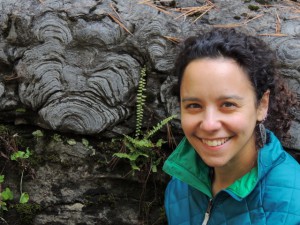By Meagan Goldman ’16
Geosciences Professor Phoebe Cohen may be young, but she’s already discovered and named an ancient fossil, created a Ted-Ed talk called “How to Fossilize Yourself”, and helped develop interdisciplinary science classes at Williams. Here, she answers a few questions for the ScientEphic.

MG: What’s your favorite fossil and why?
PC: That’s a tough one. When I was a grad student, I got the opportunity to go to the Yukon. We were following up on this paper that had been published in the early 1980s, documenting microscopic fossils that had been found only in this one place in the Yukon. They were unique because they looked like they were biomineralizing or making hard parts (like shells or skeletons), which had not been documented during the time period – this would be the earliest evidence of that happening.
I dissolved the fossils from the rock and looked at them under a scanning electron microscope. Before, they had only been viewed in 2-D in thin slices of rock, but I was able to see them in three dimensions. They were incredibly diverse and intricate. My favorite is called Quadrireticulum palmaspinosum, which basically means “four-sided net with a palm tree on it.” You get to come up with your own name when you find a new species, and the name has to have something to do with the morphology of the species, which is why I named it that. I just love that fossil because it’s really, really small and yet so intricate and detailed. It’s a crazy shape you would never expect to exist in nature, but there it is, and I was the first person to ever see it, which is pretty exciting.
MG: When and how did you first become interested in Geosciences?
PC: I was always interested in science, but when I went to college at Cornell I started off as a biology major. I was interested in things like evolution and ecology, but the biology major at Cornell was very focused on molecular and cellular processes. And so I started looking around and found that the Earth Sciences Department had a lot of courses that were about the big picture. I was interested in questions like how things got to be the way they are, and those questions I felt were mostly satisfyingly answered through the lens of the earth sciences and geosciences. So I became an earth sciences major, and I just really fell in love with it. I really enjoyed the fact that the discipline focuses on big picture questions and is also very interdisciplinary, so I still got to incorporate my love of animals and biology, but I also got to think about things in a different context than I had before.
MG: Are there any ways in which you would like to see the Geosciences Department develop at Williams?
PC: I think we have a lot of strengths for a small department – there are six faculty members, which may not seem like very many, but we all cover totally different things in terms of our research and our teaching. So we’re able to offer a really broad and diverse set of courses for our undergraduates. I would say I’d love to see more interdisciplinary work across departments. There are a lot of really great connections between chemistry, physics, biology and the geosciences, and I think it’s hard for students to double major in those departments because there’s a lot of lab work. So I’d like to see more students getting to be scientifically interdisciplinary at Williams and us finding ways to support making that happen.
MG: The Paleobiology class you teach is interdisciplinary, right?
PC: Right, so my work is inherently cross-disciplinary. Paleobiology is cross-listed as Biology. My 100-level course is cross-listed as Environmental Science, and I think some of Professor Mea Cook’s courses are also cross-listed as Environmental Science.
MG: What are you currently researching?
PC: At any one time I have many projects going on, which is fun. I just submitted a manuscript about enigmatic fossils about 700 million years old, which was before the evolution of animals. But we know that eukaryotic groups (which contain organisms more complex than bacteria, such as plants and animals) were already diversifying, and we have evidence of major groups of algae (eukaryotes) in the oceans. And so what we think we found is evidence of red algae that you can see with the naked eye, which is very unusual for this time period in earth history, as almost everything else was microscopic. We think we have found complex reproductive structures on their surfaces. That’s pretty exciting, and I’m hoping the paper gets published soon.
I’m also working on a project that is trying to compile the diversity of life before the evolution of animals, in the Precambrian time period. I’m really interested in how life evolved and changed in this time period, and how that relates to changes in the environment. For example, there are huge glacial events called Snowball Earth events that happened about 710 million years ago and again about 630 million years ago, where the globe was glaciated all the way down to the equator. So I’m interested in how that would have affected the diversity of life.
Also, this summer I’m doing fieldwork with fours students. I’m going to the Yukon to look at some of the rocks before the first snowball event and look for fossils, and then I’ll be doing some projects in upstate New York, looking at younger rocks from after the evolution of animals.